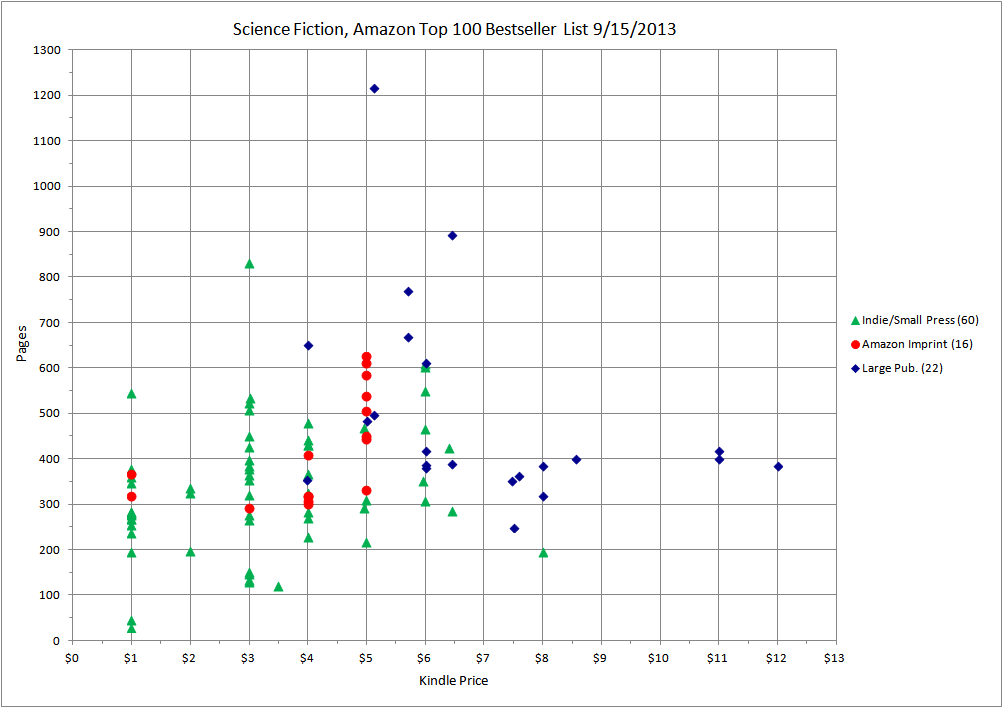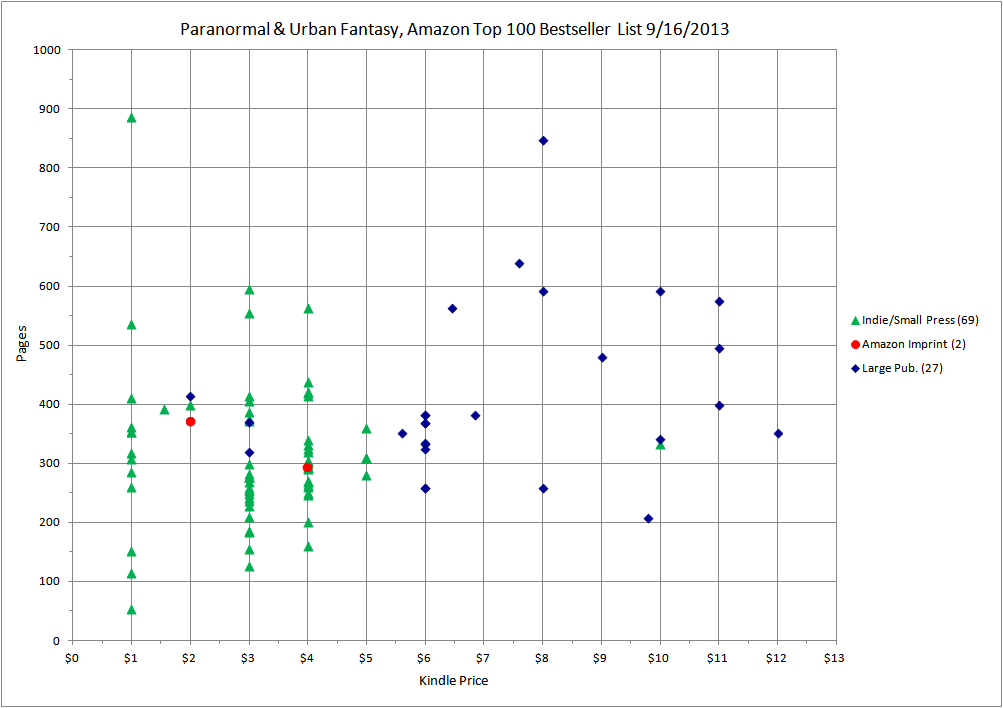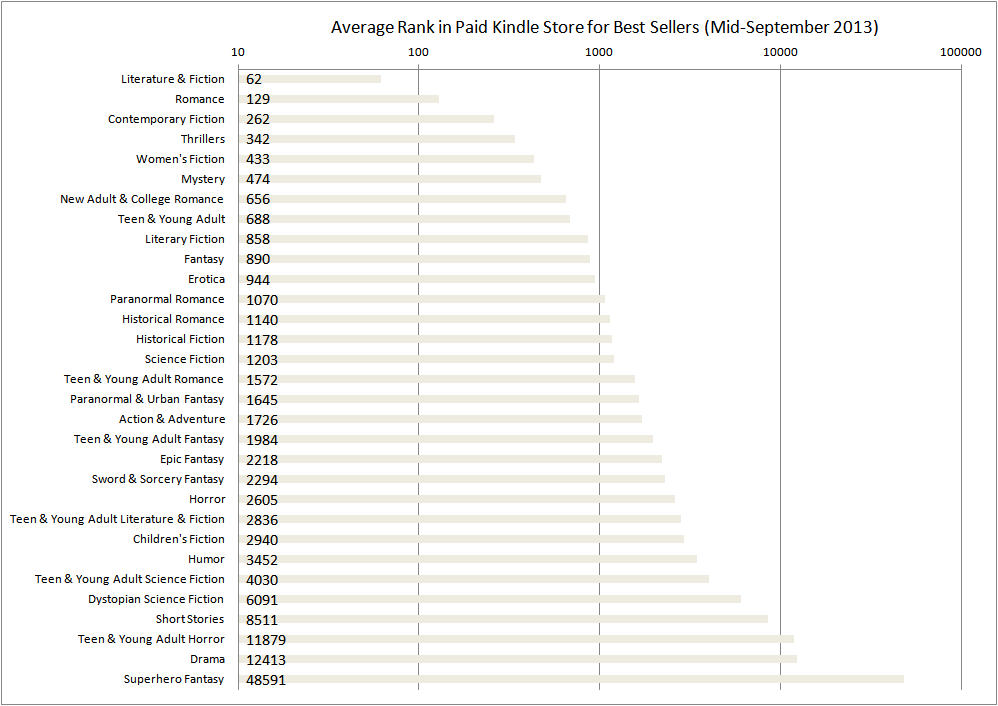In the midst of all the change happening in publishing, it’s hard to find hard data for large swaths of the industry. Sure, I have pretty hard data about what my sales are, but about the industry in general? Not so much. So, it’s with real joy that I came across this collection of data. For what it is, it’s fairly hard data, but even then, it’s has some real limitations.
So, without further delay, here it is: a site that breaks down Amazon’s Kindle Top 100 Fiction lists by Indie vs. Traditional, page count, price point, and genre. For example, here’s a chart showing for the breakdown for the top 100 in science fiction.
 Indies and small presses dominate the list with 60, compared to the Big 5 with 22. Also, the dominant price points seem to be $3 to $5 with pages counts in the 250-500 range. Paranormal and Urban fantasy looks similar:
Indies and small presses dominate the list with 60, compared to the Big 5 with 22. Also, the dominant price points seem to be $3 to $5 with pages counts in the 250-500 range. Paranormal and Urban fantasy looks similar:
 Again, the Indie/small outnumber the Big 5 by 69 to 27, and the dominant prices are $3 to $4 for 200 to 400 pages of story.
Again, the Indie/small outnumber the Big 5 by 69 to 27, and the dominant prices are $3 to $4 for 200 to 400 pages of story.
The other interesting chart is the Genre Popularity here:
 This is one is harder to read. What I’m really wanting is a market share breakdown of the different genres, and this is not that. Instead, it’s where in the ultimate Top 100 Fiction list do these various genres’ top 100 books end up? For example, the top 100 mystery novels average out to at the 474th position overall. If we assume a standard deviation (a not-at-all safe assumption), we might conclude that the 50th best-selling mystery was the 474th best-selling book on all of Kindle. For science fiction, we end up at the 1203rd spot.
This is one is harder to read. What I’m really wanting is a market share breakdown of the different genres, and this is not that. Instead, it’s where in the ultimate Top 100 Fiction list do these various genres’ top 100 books end up? For example, the top 100 mystery novels average out to at the 474th position overall. If we assume a standard deviation (a not-at-all safe assumption), we might conclude that the 50th best-selling mystery was the 474th best-selling book on all of Kindle. For science fiction, we end up at the 1203rd spot.
Now, there are plenty of caveats, many of which are listed on the page itself. Not all data is always available – you’ll note that the breakdown on many top 100 lists don’t add up to 100. Indies and small press have been lumped together. The site even goes on to say that “accuracy is not guaranteed,” but I suspect that’s a cover-your-ass disclaimer, not cover for outright deceit.
The bigger caveat is that this is for Amazon US Kindle sales. It tells us nothing about what’s happening on other e-book platforms like the Nook or Kobo, and it tells us even less about what’s happening in Barnes & Noble’s brick and mortar stores or all the various independent bookstores across the country. And it tells us nothing about what’s happening outside the US. So, in a very real sense, this data covers only a small section of the worldwide book market.
However, it’s harder data than I’m used to seeing anywhere else. Much of the coverage of print vs. e-book and indie vs. traditional publishers have been told with anecdotes and outliers. This, at least, is some hard-ish data, and it seems to say that indie publishing is a real force. Well… a real force in at least part of the market, in one format, on the one dominant platform.
It’s not much, but it is something.




 At the start of 2012, about the time I made my own decision to go Indie, the two camps were digging trenches and sharpening spears. Those in the traditional camp stood high upon the walls of their New York castles, confident in their righteous gatekeepers, and looked out upon the raging barbarians and called them deluded fools. Meanwhile, the indie camp moved openly through the fields with confidence and shook their heads at the poor word-slaves held prisoner within those very same New York castles. Between them raged a war of words so vast and vehement that I can only imagine how many novels slipped off to next year because of the wasted effort.
At the start of 2012, about the time I made my own decision to go Indie, the two camps were digging trenches and sharpening spears. Those in the traditional camp stood high upon the walls of their New York castles, confident in their righteous gatekeepers, and looked out upon the raging barbarians and called them deluded fools. Meanwhile, the indie camp moved openly through the fields with confidence and shook their heads at the poor word-slaves held prisoner within those very same New York castles. Between them raged a war of words so vast and vehement that I can only imagine how many novels slipped off to next year because of the wasted effort. But there were also some reality checks on both sides. Thousands of indie authors tossed out their one and only book, pounded out the marketing, and inexplicably did NOT become millionaires. For that matter, most did not even make $1000. It became clear that we would not all be breakout successes like Joe Konrath, Amanda Hocking, and E. L. James. Just like in traditional publishing, those were going to be the rare exception. Many realized that one book will not give them a living wage and that they did not have the patience and stamina to keep at it for ten or fifteen books before seeing much success.
But there were also some reality checks on both sides. Thousands of indie authors tossed out their one and only book, pounded out the marketing, and inexplicably did NOT become millionaires. For that matter, most did not even make $1000. It became clear that we would not all be breakout successes like Joe Konrath, Amanda Hocking, and E. L. James. Just like in traditional publishing, those were going to be the rare exception. Many realized that one book will not give them a living wage and that they did not have the patience and stamina to keep at it for ten or fifteen books before seeing much success.